Planning Nature-Based Solutions for Urban Flood Reduction and Thermal Comfort Enhancement
Abstract
1. Introduction
2. Methods and Application
2.1. Framework Description
2.2. Study Area
2.3. Hazard Assessment
2.4. Selection of NBS Types and Their Suitable Sites: Which and Where
2.5. Evaluating Effectiveness: How Much
2.5.1. Model Development and Data Analysis
2.5.2. Scenarios Development
2.5.3. Comparative Effectiveness of NBSs
3. Results and Discussion
3.1. Hazard Assessment
3.2. NBS Types Selection and Suitability Analysis (Which and Where)
- Green roof (GR), with extensive vegetation
- Pervious pavement (PP), with high albedo construction material
- Bio-retention (BR), with shrubs as topping vegetation at a height of 1.2 m
- Rain garden (RG), with street trees and lawn as topping vegetation at the height of 6 m
3.3. Effectiveness of NBS’s on Urban Flooding (How Much Impact on Flood Reduction)
3.4. The Effectiveness of NBS on Thermal Comfort Enhancement (How Much Impact on Thermal Comfort)
3.5. Discussion on NBS’s Performance
3.6. Comparative Effectiveness Scoring for the NBS
3.6.1. Comparative Effectiveness for Urban Flood Reduction
3.6.2. Comparative Effectiveness for Thermal Comfort Enhancement
3.6.3. Overall Analysis of Effectiveness and Recommendation for NBS Application
4. Conclusions
Author Contributions
Funding
Acknowledgments
Conflicts of Interest
Appendix A
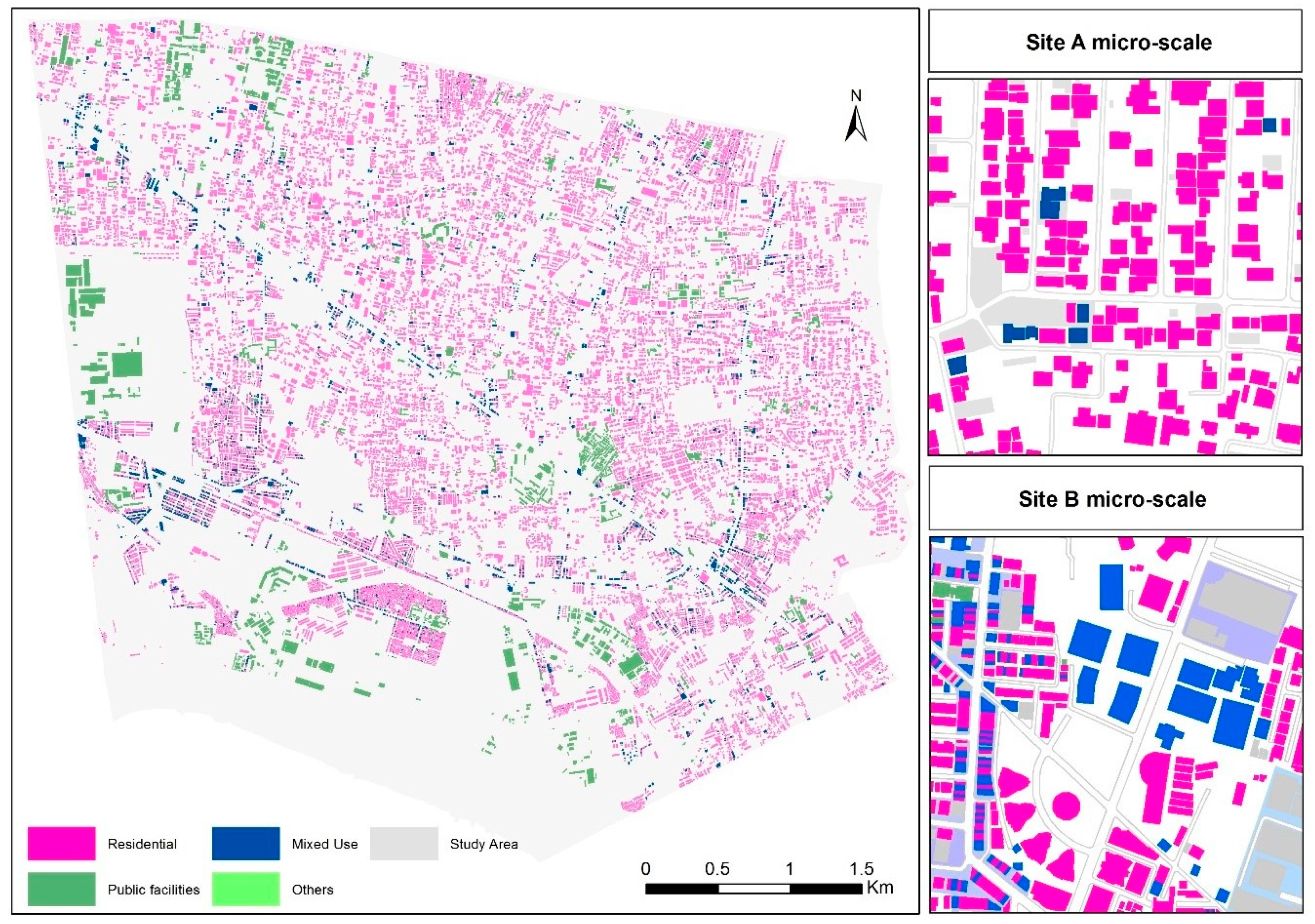
Appendix B
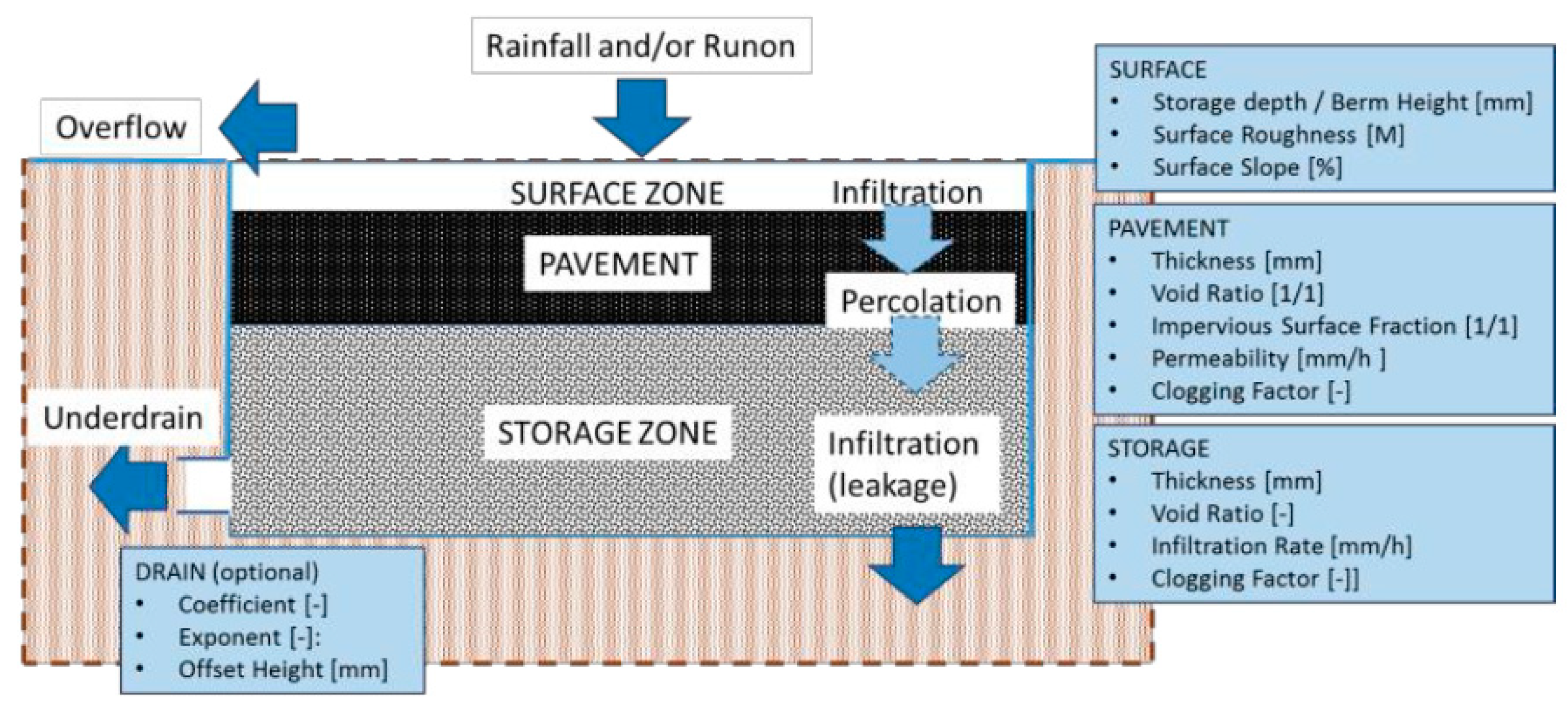
| Parameter | Unit | Value |
|---|---|---|
| Z0 Roughness | m | 0.01 |
| Albedo | fraction | 0.8 |
| Emissivity | fraction | 0.9 |
| Surface irrigated | - | No |
| Parameter (Units) | Value | Source |
|---|---|---|
| Surface | ||
| Storage height (mm) | 0 | [43] |
| Vegetation volume (fraction) | - | Assumption |
| Surface Roughness (Manning’s m) | 20 | [43] |
| Surface Slope (%) | 1 | [64,65] |
| Pavement | ||
| Thickness (mm) | 150 | [64,65] |
| Void Ratio (voids/solids) | 0.15 | [64,65] |
| Impervious Surface Fraction (fraction) | 0 | [64,65] |
| Permeability (mm/h) | 200 | [64,65] |
| Clogging Factor | 300 | Formula based |
| Storage | ||
| Height (mm) | 300 | [43,66] |
| Porosity (fraction) | 0.70 | [64,65] |
| Infiltration capacity of surrounding soil (mm/h) | 10 | [64,65] |
| Clogging Factor | 0 | Assumed no clogging |
| Drain | ||
| Drain Capacity (mm/h) | 0 | [43] |
| Drain Exponent | 0.5 | [64,65] |
| Drain Offset Height (mm) | 0 | [64,65] |
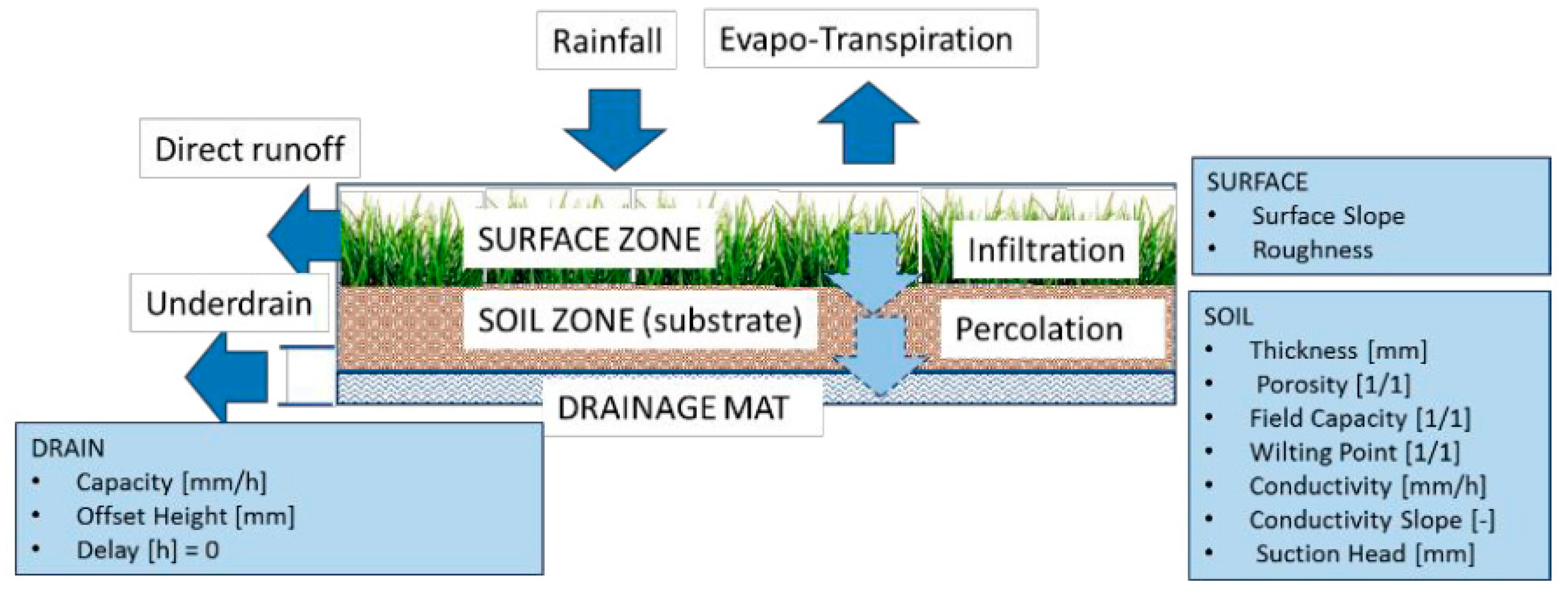
| Parameter | Unit | Value |
|---|---|---|
| Leaf Type | - | Grass |
| Albedo | fraction | 0.2 |
| Plant height | m | 0.5 |
| Root zone height | m | 0.5 |
| LAD (Leaf area density) profile | - | Default |
| RAD (Root area density) profile | - | Default |
| Parameter (Units) | Value | Source |
|---|---|---|
| Surface | ||
| Storage Depth (mm) | 20 | |
| Vegetative Volume (fraction) | 0.1 | [65] |
| Surface Roughness (Manning’s m) | 5 | [65] |
| Surface Slope (percent) | 1 | [65] |
| Soil | ||
| Thickness (mm) | 150 | [66] |
| Porosity (volume fraction) | 0.5 | [66] |
| Field Capacity (volume fraction) | 0.20 | [66] |
| Wilting Point (volume fraction) | 0.1 | [66] |
| Conductivity (mm/h) | 12.7 | [66] |
| Conductivity Slope | 10 | [66] |
| Suction Head (mm) | 88.9 | [65] |
| Drainage Mat | ||
| Thickness (mm) | 25 | [64,65] |
| Void fraction | 0.5 | [64,65] |
| Roughness (Manning M) | 5 | [64,65] |
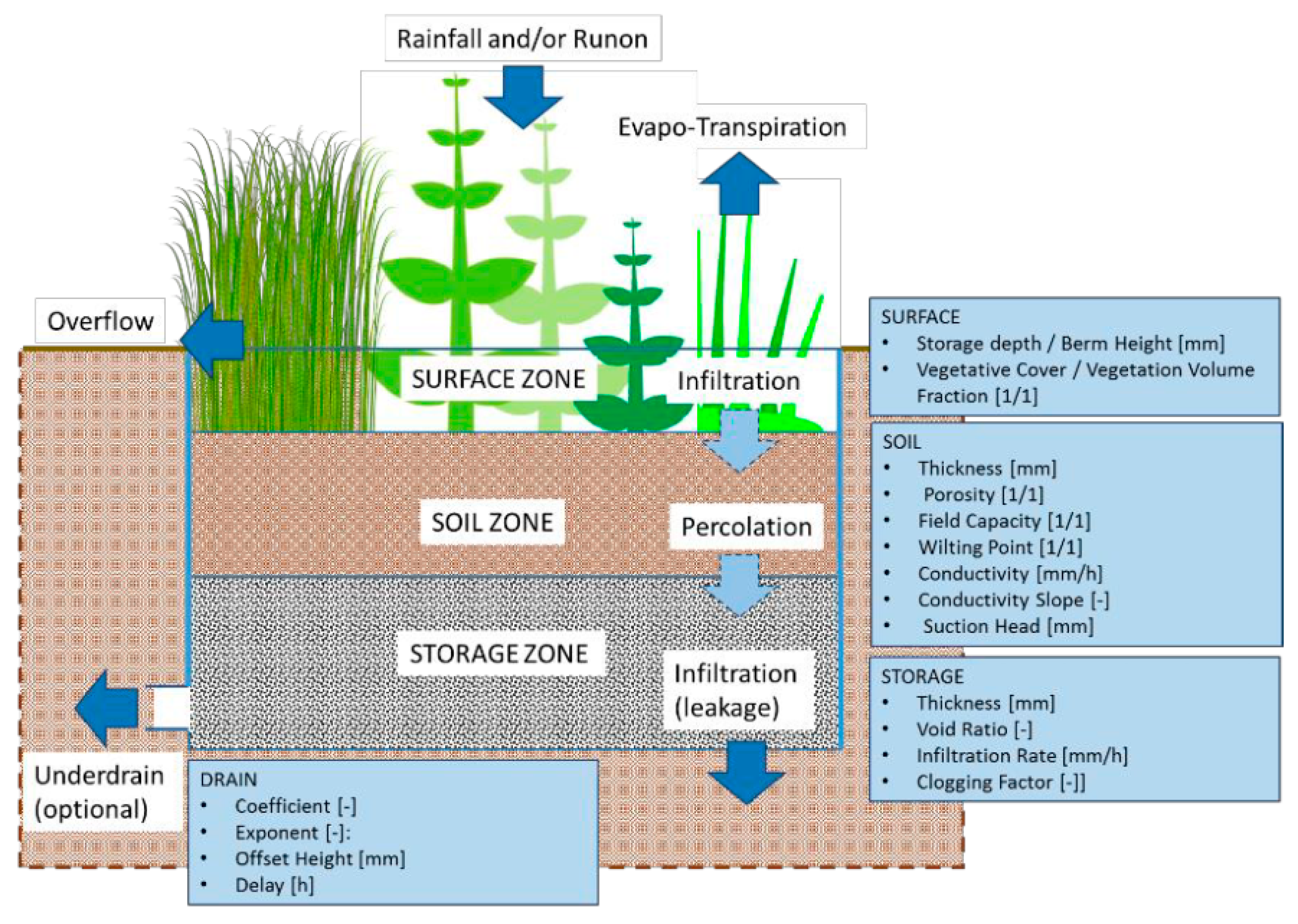
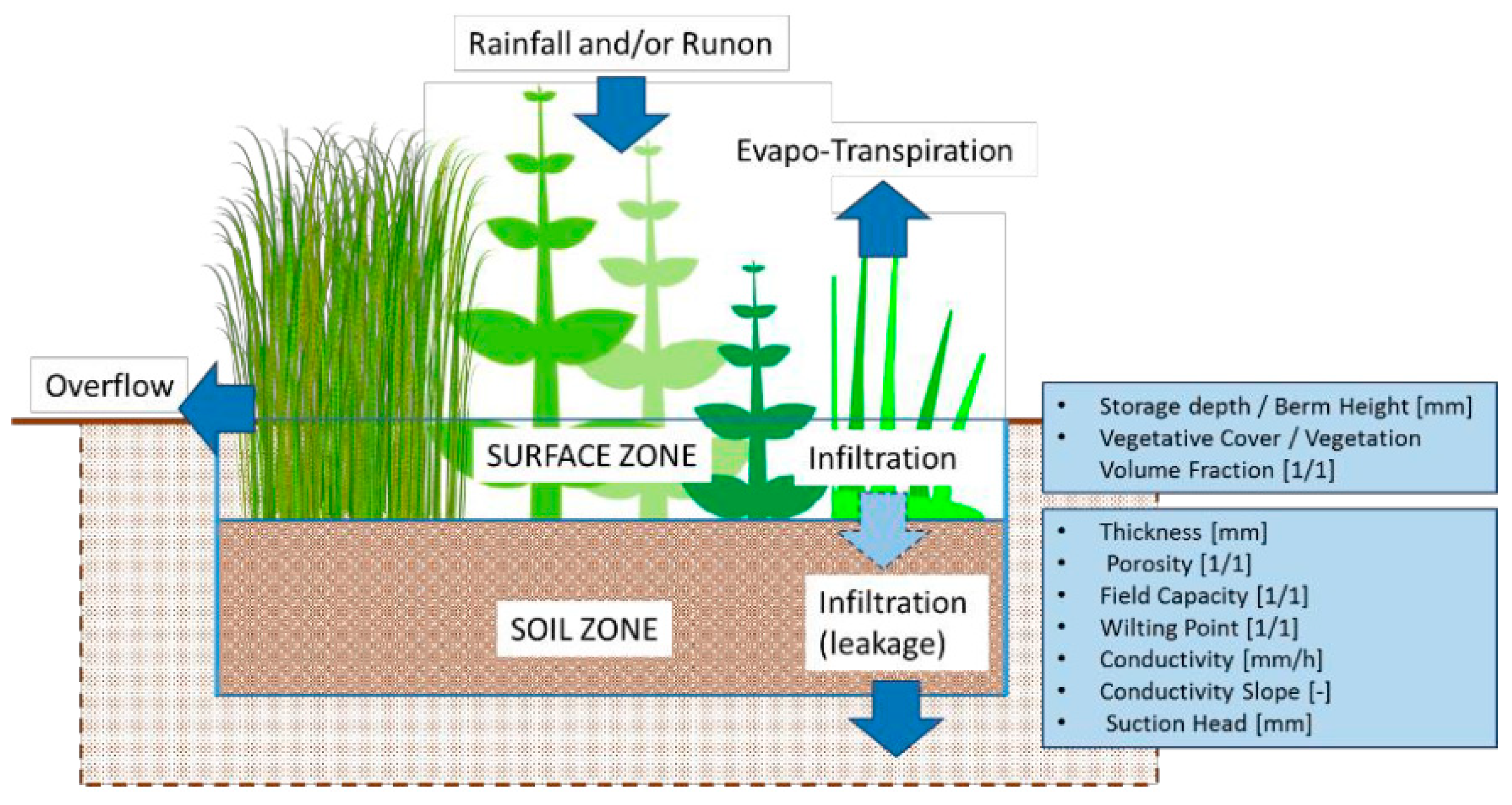
| Parameter | Unit | Value |
|---|---|---|
| Leaf Type | - | Deciduous |
| Albedo | fraction | 0.2 |
| Plant height | m | 1.2 |
| Root zone height | m | 1 |
| LAD (Leaf area density) profile | - | Default |
| RAD (Root area density) profile | - | Default |
| Parameter | Unit | Value |
|---|---|---|
| Leaf Type | - | Deciduous |
| Albedo | fraction | 0.2 |
| Plant height | m | 6.0 |
| Root zone height | m | 1 |
| LAD (Leaf area density) profile | - | Default |
| RAD (Root area density) profile | - | Default |
| Parameter (Units) | (RG) Value | (BR) Value | Source |
|---|---|---|---|
| Surface | |||
| Storage Depth (mm) | 180 | 150 | [43] |
| Vegetative Volume (fraction) | 0.10 | 0.15 | [64,65] |
| Surface Roughness (Manning’s m) | 5 | 2.5 | [64,65] |
| Surface Slope (percent) | 1 | 1 | [64,65] |
| Soil | |||
| Thickness (mm) | 800 | 550 | [66] |
| Porosity (volume fraction) | 0.5 | 0.5 | [66] |
| Field Capacity (volume fraction) | 0.20 | 0.20 | [66] |
| Wilting Point (volume fraction) | 0.10 | 0.10 | [66] |
| Conductivity (mm/h) | 12.7 | 12.7 | Default; [64] |
| Conductivity Slope | 10 | 10 | Default; [64] |
| Suction Head (mm) | 88.9 | 88.9 | Default; [64] |
| Storage | |||
| Height (mm) | 250 | [66] | |
| Void Ratio (voids/solids) | 0.70 | [66] | |
| Infiltration capacity of surrounding soil (mm/h) | 5 | [66] | |
| Clogging Factor | 0 | Assumed no clogging | |
| Underdrain | |||
| Drain Capacity (mm/h) | 0 | Default; [64] | |
| Drain Exponent | 0.5 | Default; [64] | |
| Drain Offset Height (mm) | 0 | Default; [64] |
Appendix C

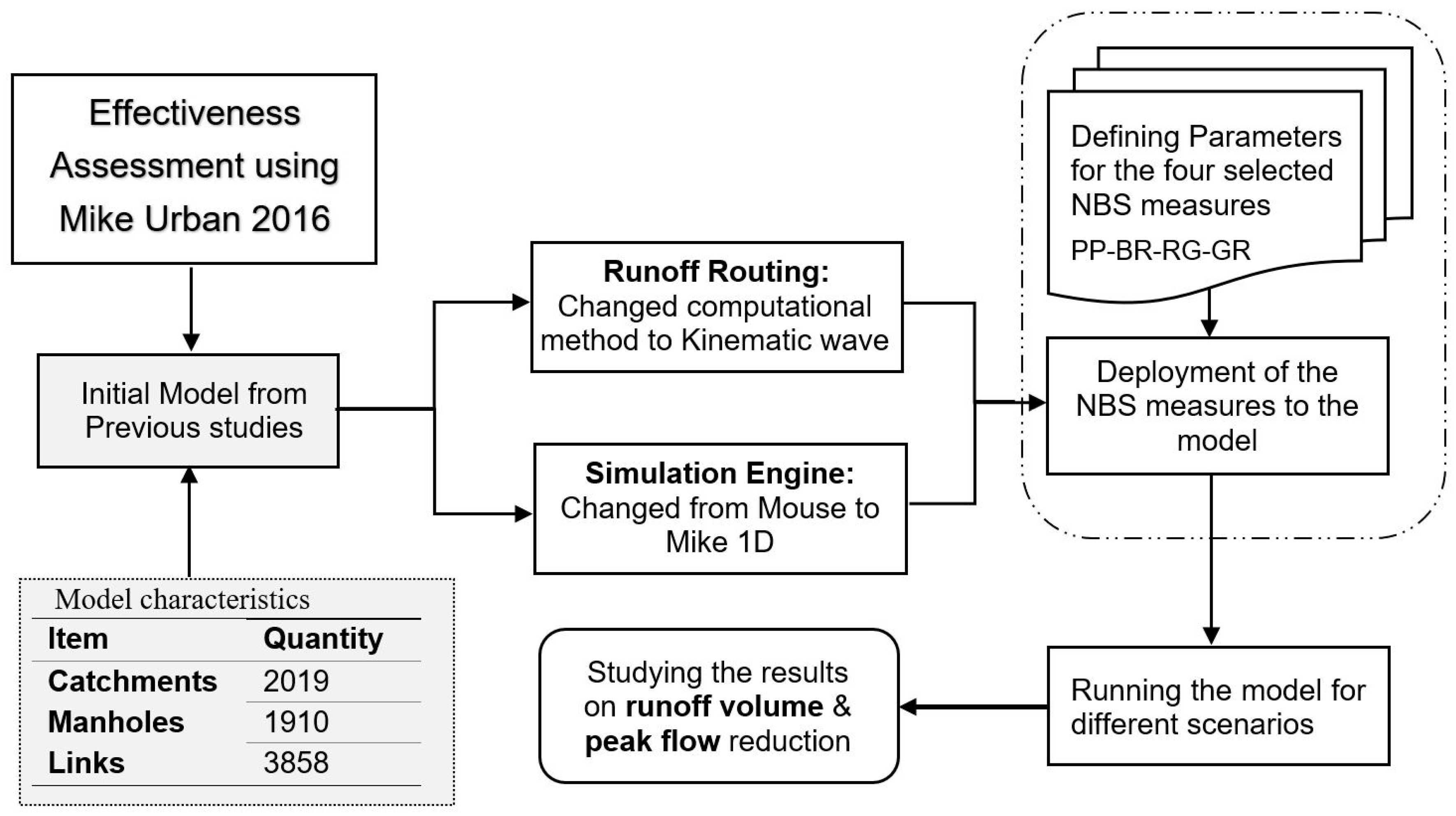
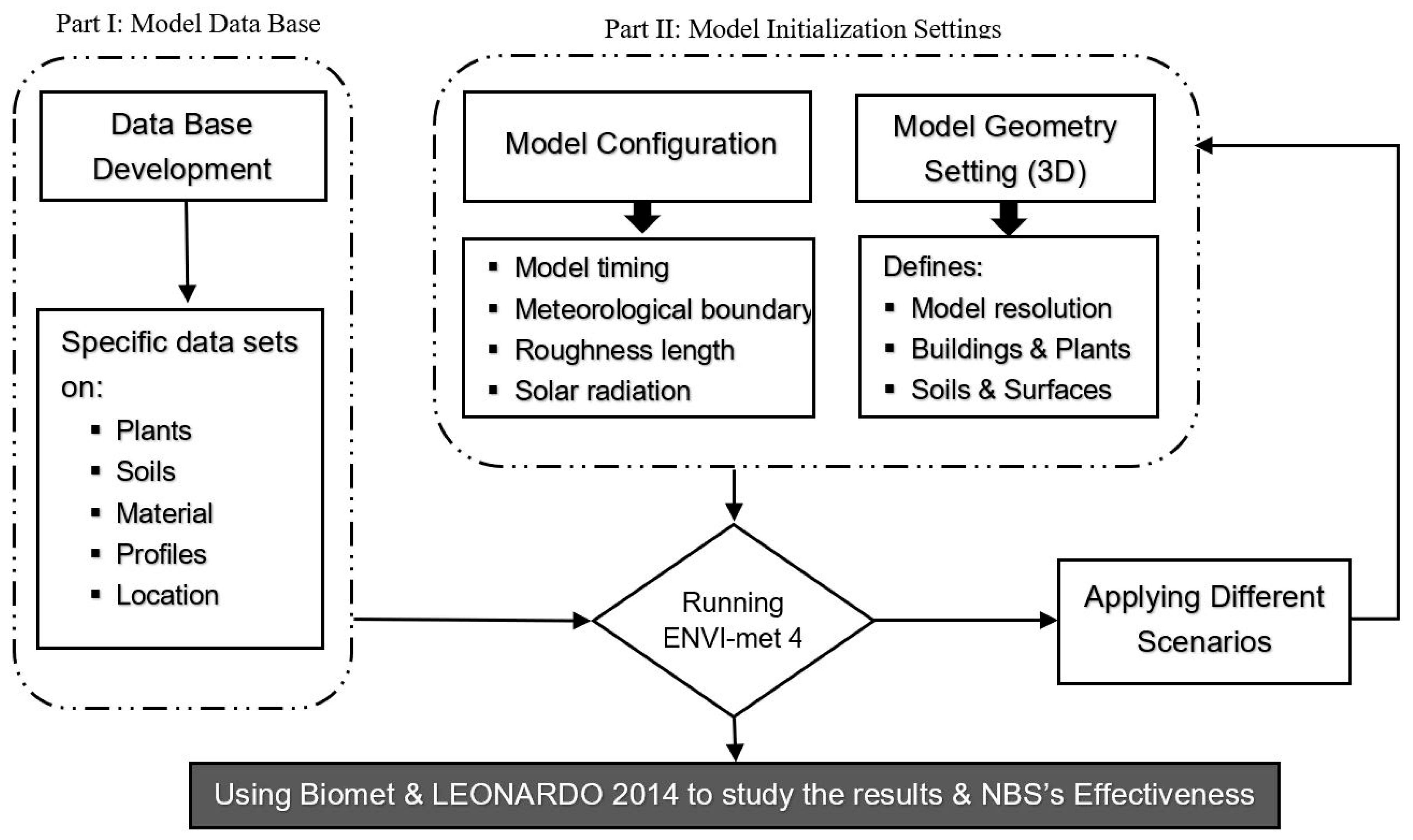
Appendix D
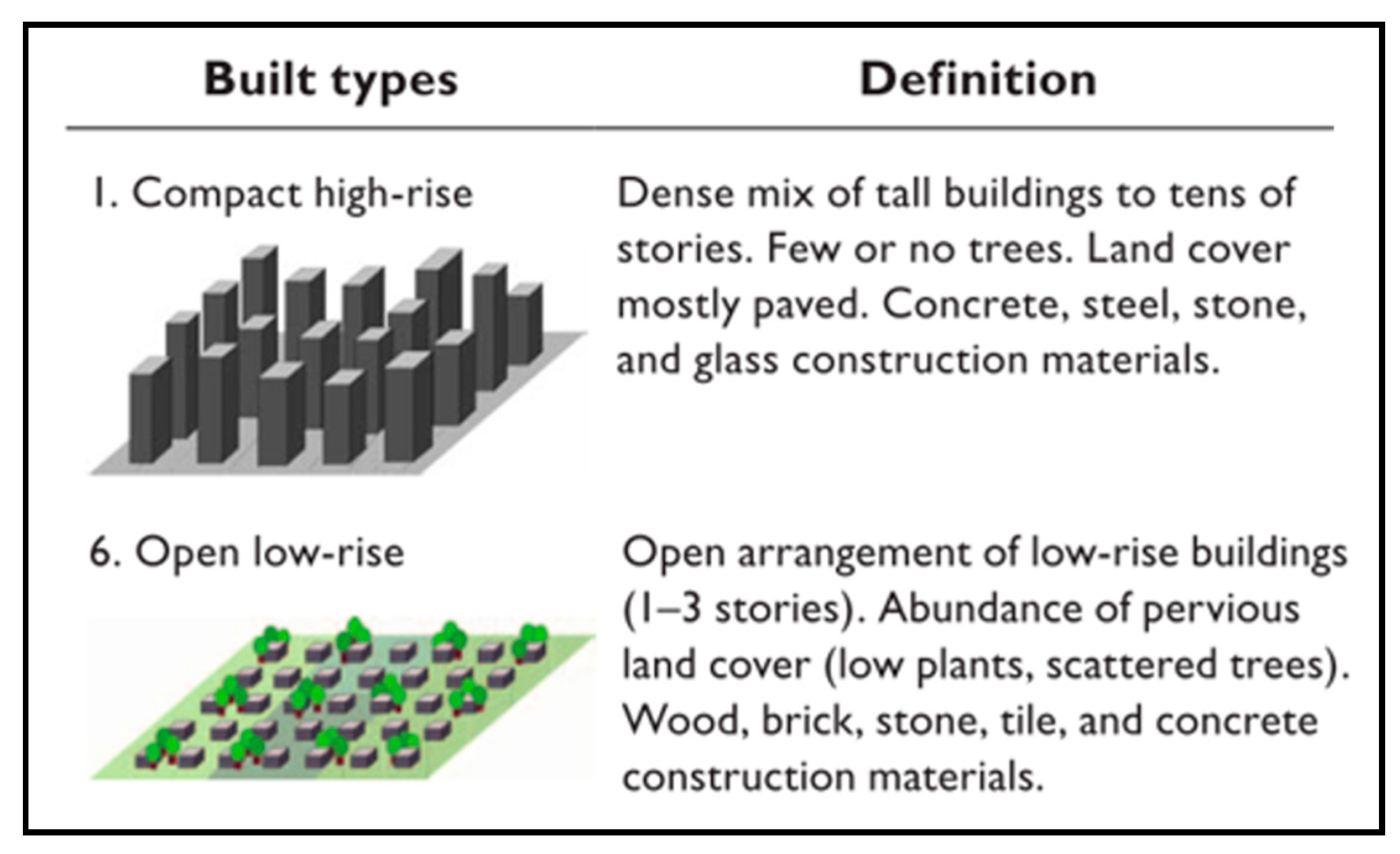
References
- Goonetilleke, A.; Thomas, E.; Ginn, S.; Gilbert, D. Understanding the role of land use in urban stormwater quality management. J. Environ. Manag. 2005, 74, 31–42. [Google Scholar] [CrossRef]
- Liu, W.; Chen, W.; Peng, C. Assessing the effectiveness of green infrastructures on urban flooding reduction: A community scale study. Ecol. Model. 2014, 291, 6–14. [Google Scholar] [CrossRef]
- Andersson-Sköld, Y.; Thorsson, S.; Rayner, D.; Lindberg, F.; Janhäll, S.; Jonsson, A.; Moback, U.; Bergman, R.; Granberg, M. An integrated method for assessing climate-related risks and adaptation alternatives in urban areas. Clim. Risk Manag. 2015, 7, 31–50. [Google Scholar] [CrossRef]
- Hilly, G.; Vojinovic, Z.; Weesakul, S.; Sanchez, A.; Hoang, D.; Djordjevic, S.; Chen, A.; Evans, B. Methodological Framework for Analysing Cascading Effects from Flood Events: The Case of Sukhumvit Area, Bangkok, Thailand. Water 2018, 10, 81. [Google Scholar] [CrossRef]
- Kovats, R.S.; Hajat, S. Heat Stress and Public Health: A Critical Review. Annu. Rev. Public Health 2008, 29, 41–55. [Google Scholar] [CrossRef]
- Derkzen, M.L.; van Teeffelen, A.J.A.; Verburg, P.H. Green infrastructure for urban climate adaptation: How do residents’ views on climate impacts and green infrastructure shape adaptation preferences? Landsc. Urban Plan. 2017, 157, 106–130. [Google Scholar] [CrossRef]
- Jia, Z.; Tang, S.; Luo, W.; Li, S.; Zhou, M. Small scale green infrastructure design to meet different urban hydrological criteria. J. Environ. Manag. 2016, 171, 92–100. [Google Scholar] [CrossRef]
- Nesshöver, C.; Assmuth, T.; Irvine, K.N.; Rusch, G.M.; Waylen, K.A.; Delbaere, B.; Haase, D.; Jones-Walters, L.; Keune, H.; Kovacs, E.; et al. The science, policy and practice of nature-based solutions: An interdisciplinary perspective. Sci. Total Environ. 2017, 579, 1215–1227. [Google Scholar] [CrossRef]
- Raymond, C.M.; Frantzeskaki, N.; Kabisch, N.; Berry, P.; Breil, M.; Nita, M.R.; Geneletti, D.; Calfapietra, C. A framework for assessing and implementing the co-benefits of nature-based solutions in urban areas. Environ. Sci. Policy 2017, 77, 15–24. [Google Scholar] [CrossRef]
- Alves, A.; Gersonius, B.; Sanchez, A.; Vojinovic, Z.; Kapelan, Z. Multi-criteria Approach for Selection of Green and Grey Infrastructure to Reduce Flood Risk and Increase CO-benefits. Water Resour. Manag. 2018, 32, 2505–2522. [Google Scholar] [CrossRef]
- Alves, A.; Gómez, J.P.; Vojinovic, Z.; Sánchez, A.; Weesakul, S. Combining Co-Benefits and Stakeholders Perceptions into Green Infrastructure Selection for Flood Risk Reduction. Environments 2018, 5, 29. [Google Scholar] [CrossRef]
- Ossa-Moreno, J.; Smith, K.M.; Mijic, A. Economic analysis of wider benefits to facilitate SuDS uptake in London, UK. Sustain. Cities Soc. 2017, 28, 411–419. [Google Scholar] [CrossRef]
- Demuzere, M.; Orru, K.; Heidrich, O.; Olazabal, E.; Geneletti, D.; Orru, H.; Bhave, A.G.; Mittal, N.; Feliu, E.; Faehnle, M. Mitigating and adapting to climate change: Multi-functional and multi-scale assessment of green urban infrastructure. J. Environ. Manag. 2014, 146, 107–115. [Google Scholar] [CrossRef] [PubMed]
- Ahiablame, L.M.; Engel, B.; Chaubey, I. Effectiveness of low impact development practices in two urbanized watersheds: Retrofitting with rain barrel/cistern and porous pavement. J. Environ. Manag. 2013, 119, 151–161. [Google Scholar] [CrossRef]
- Zahmatkesh, Z.; Burian, S.; Karamouz, M.; Tavakol-Davani, H.; Goharian, E. Low-Impact Development practices to mitigate climate change effects on urban stormwater runoff: Case study of New York City. J. Irrig. Drain. Eng. 2015, 141, 04014043. [Google Scholar] [CrossRef]
- Garcia-Ayllon, S. Long-term GIS analysis of seaside impacts associated to infrastructures and urbanization and spatial correlation with coastal vulnerability in a mediterranean area. Water (Switzerland) 2018, 10, 1642. [Google Scholar] [CrossRef]
- Hendel, M.; Gutierrez, P.; Colombert, M.; Diab, Y.; Royon, L. Measuring the effects of urban heat island mitigation techniques in the field: Application to the case of pavement-watering in Paris. Urban Clim. 2016, 16, 43–58. [Google Scholar] [CrossRef]
- Wang, Y.; Berardi, U.; Akbari, H. Comparing the effects of urban heat island mitigation strategies for Toronto, Canada. Energy Build. 2016, 114, 2–19. [Google Scholar] [CrossRef]
- Marando, F.; Salvatori, E.; Sebastiani, A.; Fusaro, L.; Manes, F. Regulating Ecosystem Services and Green Infrastructure: Assessment of Urban Heat Island effect mitigation in the municipality of Rome, Italy. Ecol. Model. 2019, 392, 92–102. [Google Scholar] [CrossRef]
- Nastran, M.; Kobal, M.; Eler, K. Urban heat islands in relation to green land use in European cities. Urban For. Urban Green. 2019, 37, 33–41. [Google Scholar] [CrossRef]
- Coccolo, S.; Pearlmutter, D.; Kaempf, J.; Scartezzini, J.L. Thermal Comfort Maps to estimate the impact of urban greening on the outdoor human comfort. Urban For. Urban Green. 2018, 35, 91–105. [Google Scholar] [CrossRef]
- Amani-Beni, M.; Zhang, B.; Xie, G.D.; Shi, Y. Impacts of urban green landscape patterns on land surface temperature: Evidence from the adjacent area of Olympic Forest Park of Beijing, China. Sustainability 2019, 11, 513. [Google Scholar] [CrossRef]
- Peng, L.L.H.; Jim, C.Y. Green-roof effects on neighborhood microclimate and human thermal sensation. Energies 2013, 6, 598–618. [Google Scholar] [CrossRef]
- Herath, H.M.P.I.K.; Halwatura, R.U.; Jayasinghe, G.Y. Evaluation of green infrastructure effects on tropical Sri Lankan urban context as an urban heat island adaptation strategy. Urban For. Urban Green. 2018, 29, 212–222. [Google Scholar] [CrossRef]
- Galagoda, R.U.; Jayasinghe, G.Y.; Halwatura, R.U.; Rupasinghe, H.T. The impact of urban green infrastructure as a sustainable approach towards tropical micro-climatic changes and human thermal comfort. Urban For. Urban Green. 2018, 34, 1–9. [Google Scholar] [CrossRef]
- Tsoka, S.; Tsikaloudaki, A.; Theodosiou, T. Analyzing the ENVI-met microclimate model’s performance and assessing cool materials and urban vegetation applications—A review. Sustain. Cities Soc. 2018, 43, 55–76. [Google Scholar] [CrossRef]
- Crank, P.J.; Sailor, D.J.; Ban-Weiss, G.; Taleghani, M. Evaluating the ENVI-met microscale model for suitability in analysis of targeted urban heat mitigation strategies. Urban Clim. 2018, 26, 188–197. [Google Scholar] [CrossRef]
- World Bank. East Asia’s Changing Urban Landscape: Measuring a Decade of Spatial Growth; World Bank: Washington, DC, USA, 2015. [Google Scholar]
- Srivanit, M.; Hokao, K.; Phonekeo, V. Assessing the Impact of Urbanization on Urban Thermal Environment: A Case Study of Bangkok Metropolitan. Int. J. Appl. Sci. Technol. 2012, 2, 243–256. [Google Scholar]
- Rehan, M.M.; Weesakul, S.; Chaowiwat, W.; Charoensukrungruang, W. Development of Design Storm Pattern with Climate Change in Monsoon Asia. In Proceedings of the THA 2017 International Conference on “Water Management and Climate Change Towards Asia’s Water-Energy-Food Nexus”, Bangkok, Thailand, 25–27 January 2017. [Google Scholar]
- Sheikh, Z.A. Farmer’s Perceived Agricultural Adaptation to Climate Change Impact in Rangsit Canal Area of Nong Sua District, Thailand; Asian Institute of Technology: Bangkok, Thailand, 2016. [Google Scholar]
- Arifwidodo, S.D.; Tanaka, T. The Characteristics of Urban Heat Island in Bangkok, Thailand. Procedia-Soc. Behav. Sci. 2015, 195, 423–428. [Google Scholar] [CrossRef]
- Mark, O.; Weesakul, S.; Apirumanekul, C.; Aroonnet, S.B.; Djordjević, S. Potential and limitations of 1D modelling of urban flooding. J. Hydrol. 2004, 299, 284–299. [Google Scholar] [CrossRef]
- Price, R.K.; Vojinovic, Z. Urban Hydroinformatics: Data, Models and Decision Support for Integrated Urban Water Management, 1st ed.; IWA Publishing: London, UK, 2011. [Google Scholar]
- Stewart, I.D.; Oke, T.R. Local climate zones for urban temperature studies. Bull. Am. Meteorol. Soc. 2012, 93, 1879–1900. [Google Scholar] [CrossRef]
- Coccolo, S.; Kämpf, J.; Scartezzini, J.L.; Pearlmutter, D. Outdoor human comfort and thermal stress: A comprehensive review on models and standards. Urban Clim. 2016, 18, 33–57. [Google Scholar] [CrossRef]
- Hoppe, P. The physiological equivalent temperature—A universal index for the biometeorological assessment of the thermal environment. Int. J. Biometeorol. 1999, 43, 71–75. [Google Scholar] [CrossRef] [PubMed]
- ISO 7726. Ergonomics of the Thermal Environment, Instruments of Measuring Physical Quantities; ISO: Geneva, Switzerland, 1998. [Google Scholar]
- Ahiablame, L.M.; Engel, B.; Chaubey, I. Effectiveness of Low Impact Development Practices: Literature Review and Suggestions for Future Research. Water Air Soil Pollut. 2012, 223, 4253–4273. [Google Scholar] [CrossRef]
- Connop, S.; Vandergert, P.; Eisenberg, B.; Collier, M.J.; Nash, C.; Clough, J.; Newport, D. Renaturing cities using a regionally-focused biodiversity-led multifunctional benefits approach to urban green infrastructure. Environ. Sci. Policy 2015, 62, 99–111. [Google Scholar] [CrossRef]
- Sharma, R.; Joshi, P.K. Mapping environmental impacts of rapid urbanization in the National Capital Region of India using remote sensing inputs. Urban Clim. 2016, 15, 70–82. [Google Scholar] [CrossRef]
- Tetra Tech. BMP Siting Tool: Step-by-Step Guide; Tetra Tech: Pasadena, CA, USA, 2013. [Google Scholar]
- DHI. Storm Water Runoff from Green Urban Areas—Modellers’ Guideline; DHI: Hørsholm, Danmark, 2015. [Google Scholar]
- Vojinovic, Z.; Tutulic, D. On the use of 1D and coupled 1D-2D approaches for assessment of flood damages in urban areas. Urban Water J. 2009, 6, 183–199. [Google Scholar] [CrossRef]
- ENVI-met. Available online: https://www.envi-met.com/ (accessed on 1 December 2016).
- Berardi, U. The outdoor microclimate benefits and energy saving resulting from green roofs retrofits. Energy Build. 2016, 121, 217–229. [Google Scholar] [CrossRef]
- Bruse, M. Simulating microscale climate interactions in complex terrain with a high-resolution numerical model: A case study for the Sydney CBD Area (Model Description). In Proceedings of the International Conference on Urban Climatology & International Congress of Biometeorology, Sydney, Australia, 8 November 1999. [Google Scholar]
- Salata, F.; Golasi, I.; de Lieto Vollaro, R.; de Lieto Vollaro, A. Urban microclimate and outdoor thermal comfort. A proper procedure to fit ENVI-met simulation outputs to experimental data. Sustain. Cities Soc. 2016, 26, 318–343. [Google Scholar] [CrossRef]
- Yang, X.; Zhao, L.; Bruse, M.; Meng, Q. Evaluation of a microclimate model for predicting the thermal behavior of different ground surfaces. Build. Environ. 2013, 60, 93–104. [Google Scholar] [CrossRef]
- ASHRAE. Standard 55—Thermal Environmental Conditions for Human Occupacy; ASHRAE: Atlanta, GA, USA, 2013. [Google Scholar]
- Lee, H.; Mayer, H.; Chen, L. Contribution of trees and grasslands to the mitigation of human heat stress in a residential district of Freiburg, Southwest Germany. Landsc. Urban Plan. 2016, 148, 37–50. [Google Scholar] [CrossRef]
- Perini, K.; Magliocco, A. Effects of vegetation, urban density, building height, and atmospheric conditions on local temperatures and thermal comfort. Urban For. Urban Green. 2014, 13, 495–506. [Google Scholar] [CrossRef]
- Vailshery, L.S.; Jaganmohan, M.; Nagendra, H. Effect of street trees on microclimate and air pollution in a tropical city. Urban For. Urban Green. 2013, 12, 408–415. [Google Scholar] [CrossRef]
- Jamei, E.; Rajagopalan, P. The effect of green roof on pedestrian level air temperature. In Proceedings of the 14th Conference of International Building Performance Simulation Associatiion, Hyderabad, India, 7–9 December 2015. [Google Scholar]
- Lobaccaro, G.; Acero, J.A. Comparative analysis of green actions to improve outdoor thermal comfort inside typical urban street canyons. Urban Clim. 2015, 14, 251–267. [Google Scholar] [CrossRef]
- Sharma, A.; Conry, P.; Fernando, H.J.S.; Hamlet, A.F.; Hellmann, J.J.; Chen, F. Green and cool roofs to mitigate urban heat island effects in the Chicago metropolitan area: Evaluation with a regional climate model. Environ. Res. Lett. 2016, 11, 064004. [Google Scholar] [CrossRef]
- Hedquist, B.C.; Brazel, A.J. Seasonal variability of temperatures and outdoor human comfort inPhoenix, Arizona, U.S.A. Build. Environ. 2014, 72, 377–388. [Google Scholar] [CrossRef]
- Rizwan, A.M.; Dennis, L.Y.C.; Liu, C. A review on the generation, determination and mitigation of Urban Heat Island. J. Environ. Sci. 2008, 20, 120–128. [Google Scholar] [CrossRef]
- Carpenter, D.D.; Kaluvakolanu, P. Effect of Roof Surface Type on Storm-Water Runoff from Full-Scale Roofs in a Temperate Climate. J. Irrig. Drain. Eng. 2011, 137, 161–169. [Google Scholar] [CrossRef]
- Berardi, U.; GhaffarianHoseini, A.H.; GhaffarianHoseini, A. State-of-the-art analysis of the environmental benefits of green roofs. Appl. Energy 2014, 115, 411–428. [Google Scholar] [CrossRef]
- Duarte, D.H.S.; Shinzato, P.; Gusson, C.D.S.; Alves, C.A. The impact of vegetation on urban microclimate to counterbalance built density in a subtropical changing climate. Urban Clim. 2015, 14, 224–239. [Google Scholar] [CrossRef]
- Wang, Y.; Akbari, H. The effects of street tree planting on Urban Heat Island mitigation in Montreal. Sustain. Cities Soc. 2016, 27, 122–128. [Google Scholar] [CrossRef]
- Vijayaraghavan, K. Green roofs: A critical review on the role of components, benefits, limitations and trends. Renew. Sustain. Energy Rev. 2016, 57, 740–752. [Google Scholar] [CrossRef]
- Kjølby, M.J. Modellering af LAR Anlæg Samt Modellering af Stoffjernelse i LAR Anlæg og Bassiner. Available online: http://www.evanet.dk/modellering-af-lar-anlaeg-samt-modellering-af-stoffjernelse-i-lar-anlaeg-og-bassiner/ (accessed on 1 December 2016).
- James, W.; Rossman, L.E.; James, R.C. User Guide to SWMM5; CHI Press: Guelph, ON, Canada, 2010. [Google Scholar]
- Rossman, L.A. Storm Water Management Model User’s Manual Version 5.1; US EPA: Cincinnati, OH, USA, 2015. [Google Scholar]
- Gao, J.; Wang, R.; Huang, J.; Liu, M. Application of BMP to urban runoff control using SUSTAIN model: Case study in an industrial area. Ecol. Model. 2015, 318, 177–183. [Google Scholar] [CrossRef]
- Mao, X.; Jia, H.; Yu, S.L. Assessing the ecological benefits of aggregate LID-BMPs through modelling. Ecol. Model. 2016, 353, 139–149. [Google Scholar] [CrossRef]
- Maryati, S.; Humaira, A.N.S.; Adianti, P. Green Infrastructure Development in Cisangkuy Subwatershed, Bandung Regency: Potential and Problems. Procedia-Soc. Behav. Sci. 2016, 227, 617–622. [Google Scholar] [CrossRef][Green Version]
- Elliott, A.; Trowsdale, S. A review of models for low impact urban stormwater drainage. Environ. Model. Softw. 2007, 22, 394–405. [Google Scholar] [CrossRef]
- Zhou, Q. A review of sustainable urban drainage systems considering the climate change and urbanization impacts. Water 2014, 6, 976–992. [Google Scholar] [CrossRef]
- Declet-Barreto, J.; Brazel, A.J.; Martin, C.A.; Chow, W.T.L.; Harlan, S.L. Creating the park cool island in an inner-city neighborhood: Heat mitigation strategy for Phoenix, AZ. Urban Ecosyst. 2013, 16, 617–635. [Google Scholar] [CrossRef]
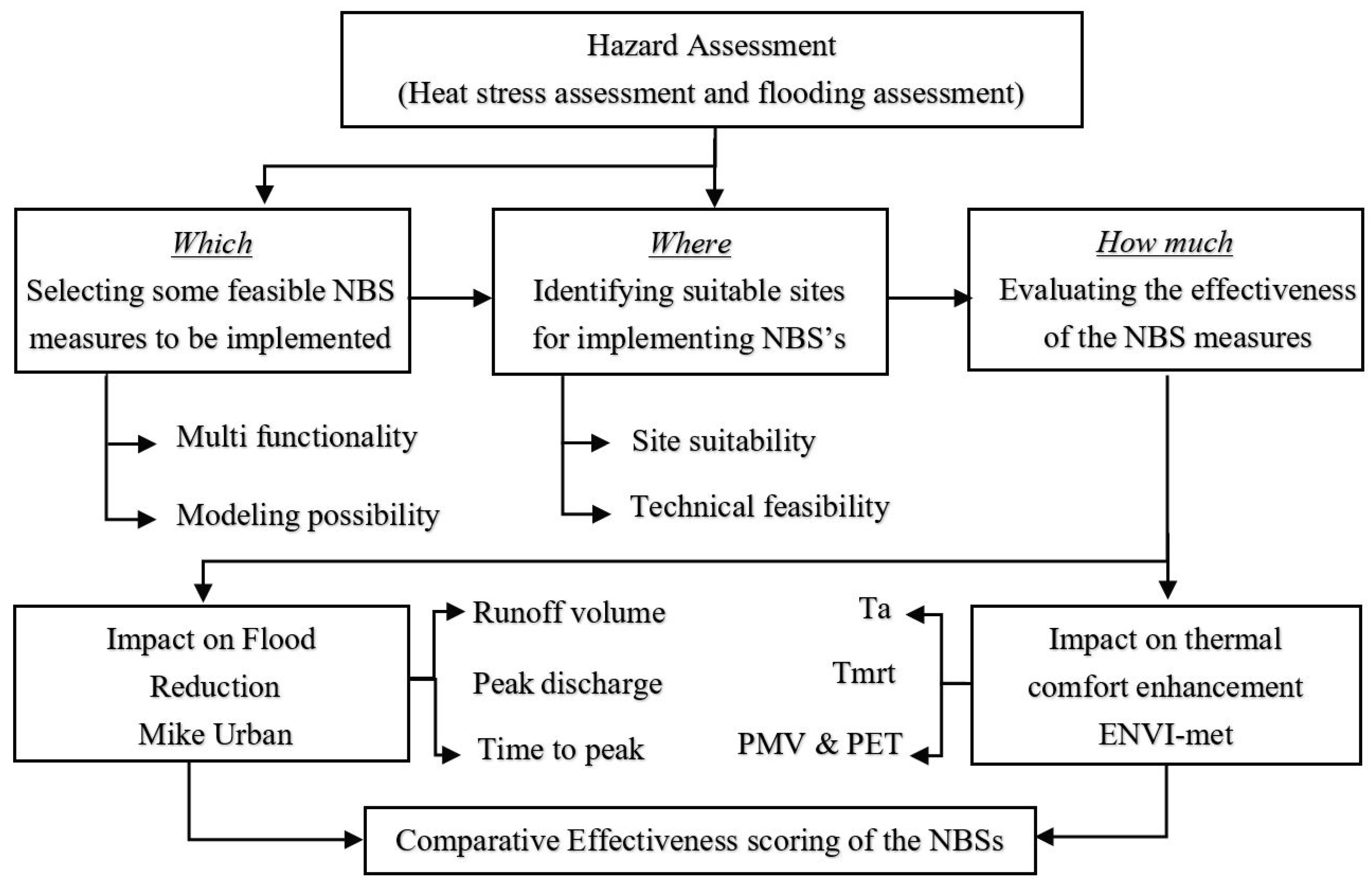
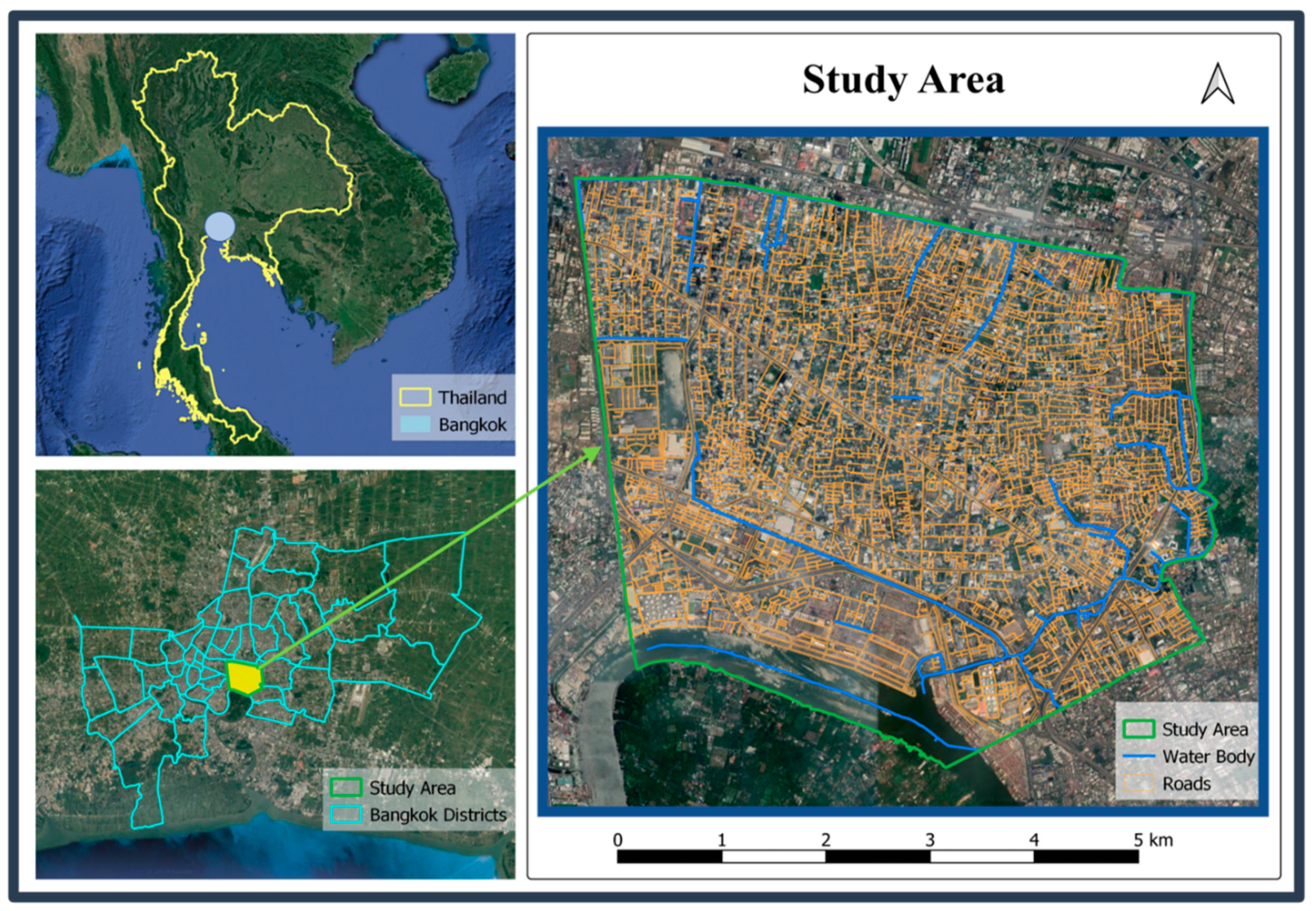
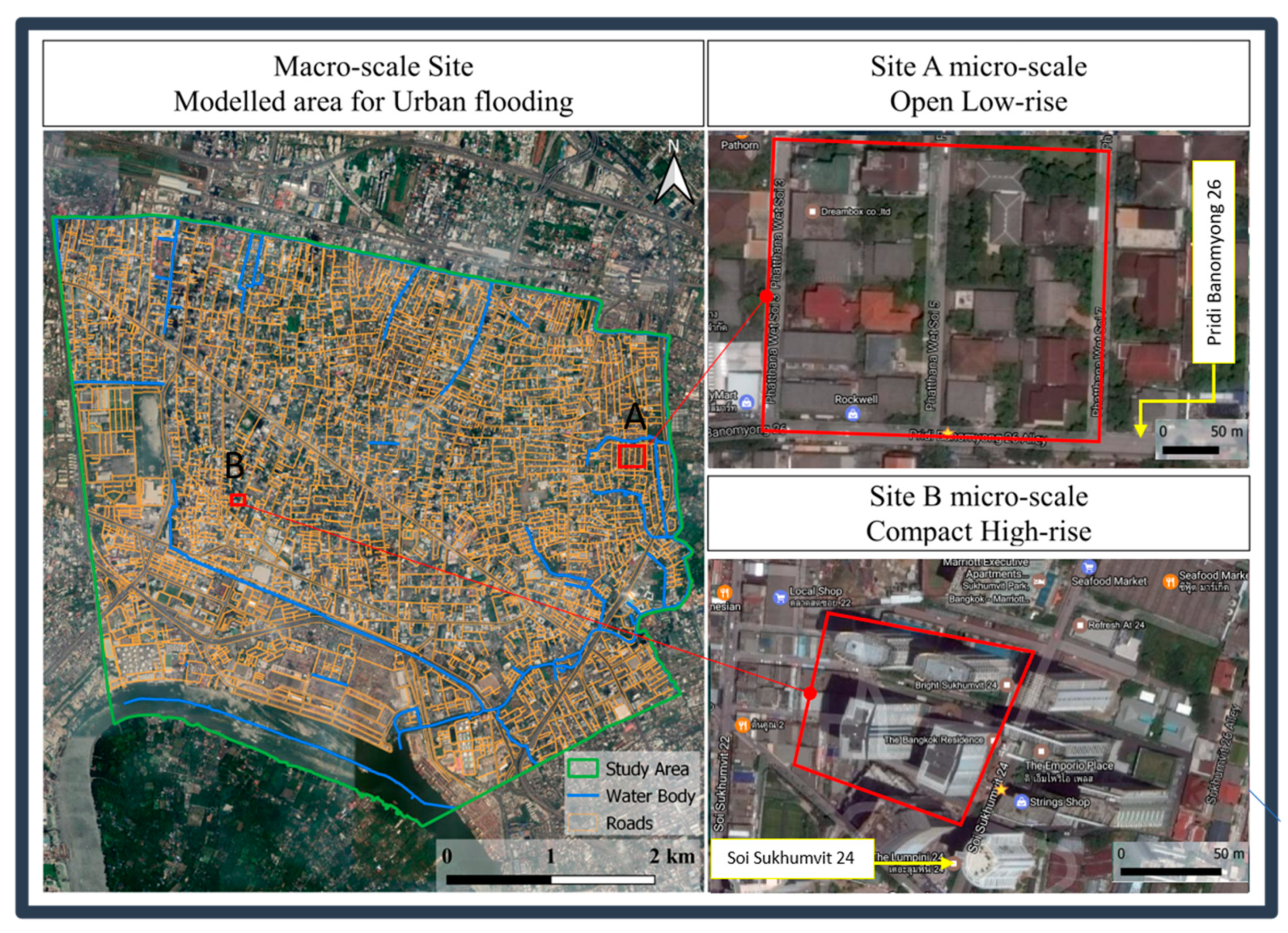
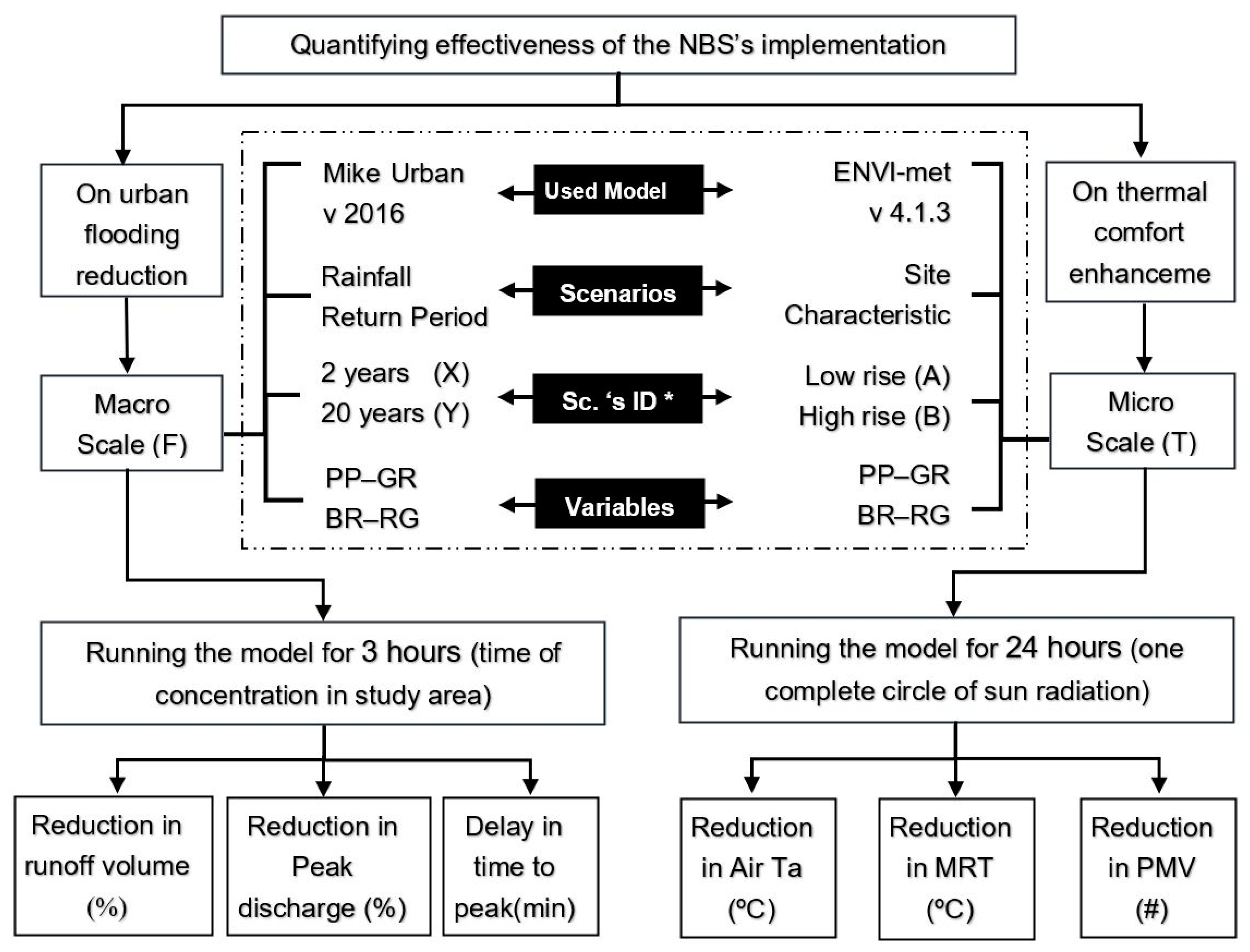
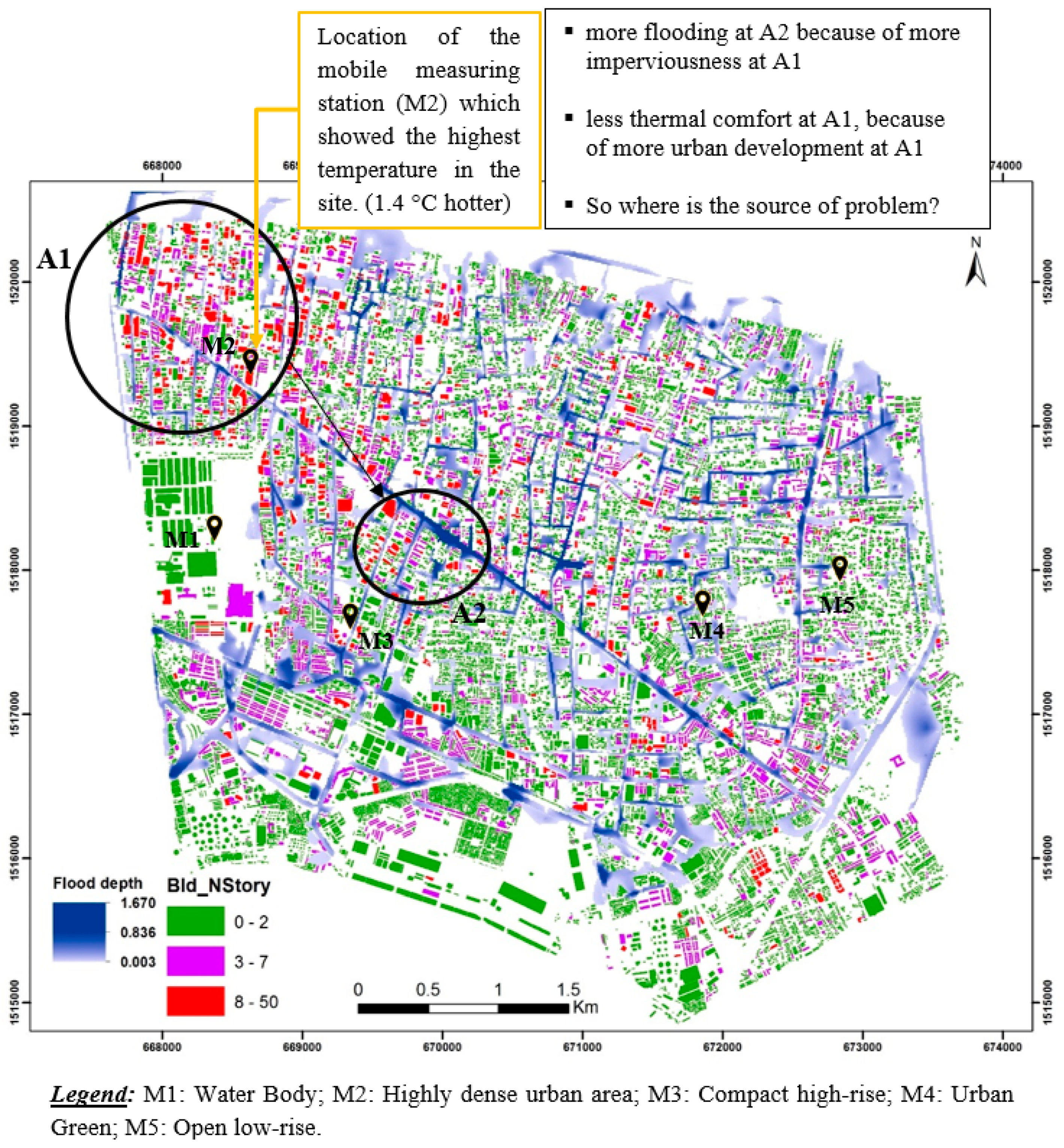
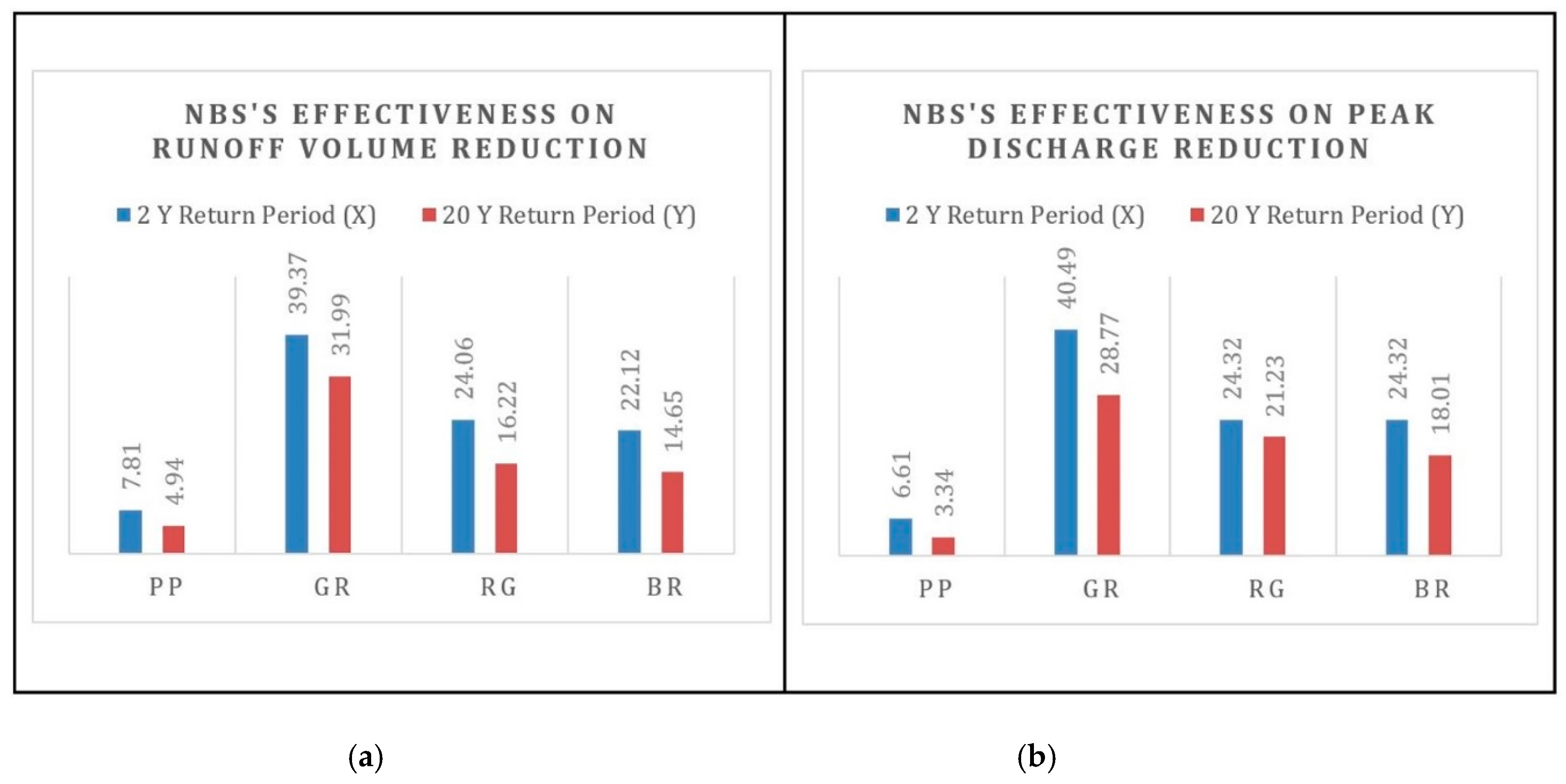
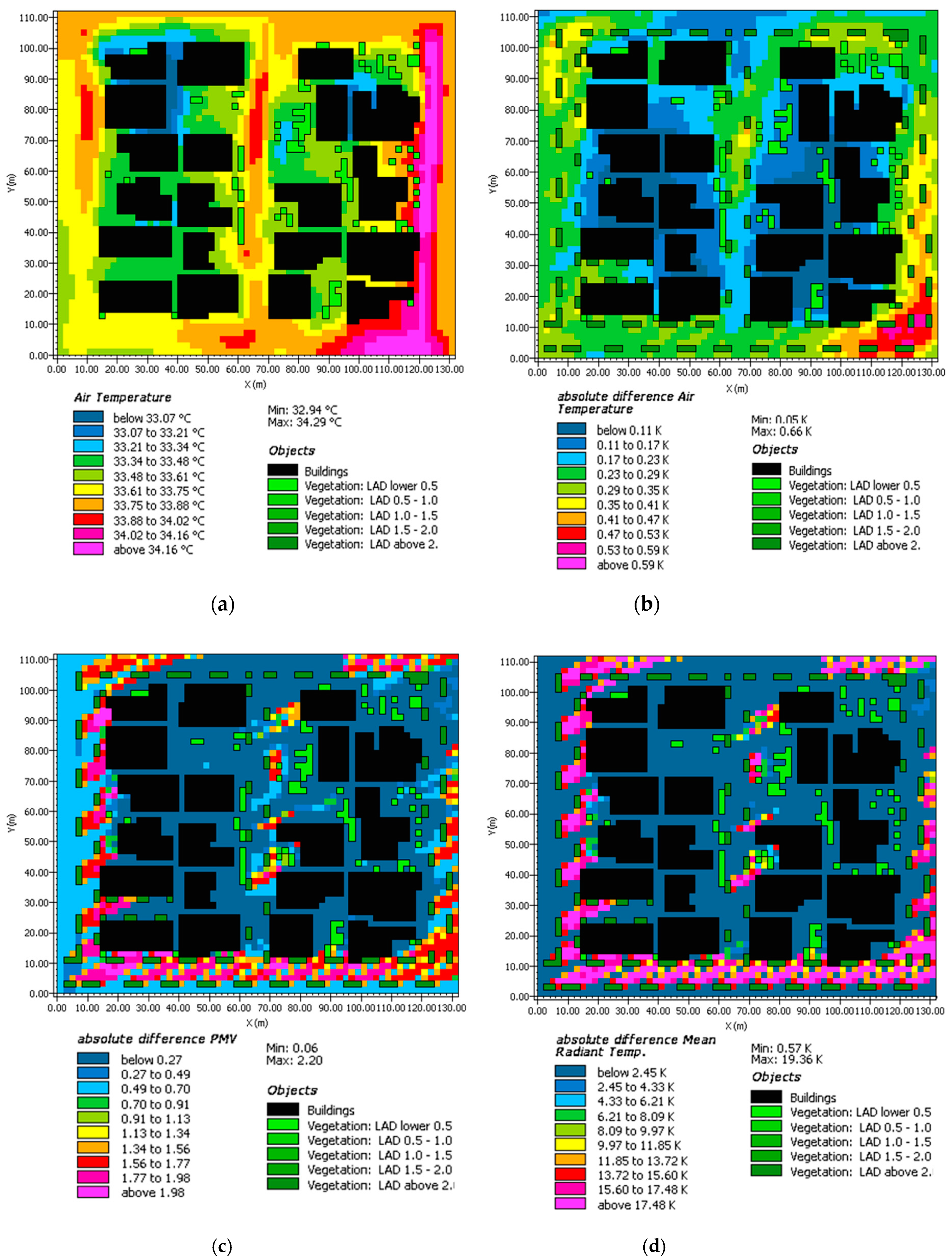
| Sn | ID | Installed Height | Type of Measurement | Characteristic of the Location |
|---|---|---|---|---|
| 1 | M1 | 1.4 m | Mobile | Water Body |
| 2 | M2 | 1.4 m | Mobile | Highly dense urban area (high vehicle traffic and buildings construction) |
| 3 | M3 | 1.4 m | Mobile | Compact high-rise |
| 4 | M4 | 1.4 m | Mobile | Urban Green (Park) |
| 5 | M5 | 1.4 m | Mobile | Open low-rise |
| NBS ID | Mike Urban Model (Scenarios X & Y) | ENVI-Met Model (Scenarios A & B) | ||
|---|---|---|---|---|
| Inputs | Outputs | Inputs | Outputs | |
| PP (Pervious Pavement) | Surface, Pavement, Storage and Drain parameters | The amount of change in volume, flow and time to peak for each of the X and Y Scenarios and for each of the variables. | The surface Albedo and emissivity of the PP is changed from 0.4 to 0.8. | The average of change in Ta, MRT and PMV for each of the scenarios A and B and for each of the variables. |
| GR (Green Roof) | Surface, Soil and Drainage mat parameters | Grass on top of the buildings. The characteristics of the grass are LAD, Albedo, Cell size and intensity. | ||
| BR (Bio-Retention) | Surface, Soil, storage and Underdrain parameters | The Green area percentage is increase by 5%. The inputs are Number of trees, LAD, RAD, plant height, Albedo and Leaf type. | ||
| RG (Rain Garden) | Surface and Soil parameters | The Green area percentage is increase by 5%. The inputs are Number of trees, LAD, RAD, plant height, Albedo and Leaf type. | ||
| Measures and Their Implemented Scenarios for Assessment of Urban Flood Reduction (F)—Macro Scale | |||
|---|---|---|---|
| Implemented Measures | Description of Measures | Scenarios According to Rainfall Return Periods | |
| 2 Year | 20 Year | ||
| Business as usual | Business as usual | X-B | Y-B |
| PP (all str. and pavements) (implementing area: 15%) | Pervious Pavements (with high albedo material) | X-PP | Y-PP |
| GR (all feasible roofs) (implementing area: 27%) | Green roof (extensive vegetation) | X-GR | Y-GR |
| BR (alongside the streets) (implementing area: 4%) | Bio-retention (with shrub/bush) | X-BR | Y-BR |
| RG (alongside the streets) (implementing area: 4%) | Rain garden (with street trees) | X-RG | Y-RG |
| Scenarios for Thermal Comfort Effectiveness Assessment (T)—Micro Scale | |||
|---|---|---|---|
| Implemented Measures | Description of Measures | Scenarios According to Site Characterizes | |
| Low Rise | High Rise | ||
| Business as usual | Business as usual | A-B | B-B |
| PP (all str. and pavements) (implementing area: 25%) | Changing the albedo from 0.4 to 0.8 | A-PP | B-PP |
| GR (all feasible roofs) (implementing area: 35%) | Adding 50 cm height grass on top of the roofs | A-GR | B-GR |
| BR (alongside the street) (implementing area: 5%) | Planting shrubs (1.2 m height) alongside the street edges | A-BR | B-BR |
| RG (alongside the street) (implementing area: 5%) | Planting trees (6.0 m height) alongside the street edges | A-RG | B-RG |
| Simulated Sub-Scenario (NBS’s Variation) | Description of Measures | Max Reduction in Ta 4:00 p.m. (°C) | Max Reduction in Tmrt at 4:00 p.m. (°C) | Max Reduction in PMV at 4:00 p.m. (−5 to 5) |
|---|---|---|---|---|
| Open Low rise buildings (Site A) | ||||
| A-PP | Changing the albedo from 0.4 to 0.8 | 0.41 | −0.6 (from 51.18) | 0.68 (from 4.67) |
| A-GR | Adding 50 cm height grass on top of the roofs | 0.17 | 17.81 (from 51.18) | 0.8 (from 4.67) |
| A-BR | Planting shrubs (1.3 m height) alongside the street edges | 0.16 | 16.2 (from 51.18) | 1.52 (from 4.67) |
| A-RG | Planting trees (6.0 m height) alongside the street edges | 0.66 | 19.36 (from 51.18) | 2.21 (from 4.67) |
| Compact high-rise buildings (Site B) | ||||
| B-PP | Changing the albedo from 0.4 to 0.8 | 0.10 | −0.69 (from 52.31) | −0.05 (from 4.09) |
| B-GR | Adding 50 cm height grass on top of the roofs | 0.00 | 0.10 (from 52.31) | 0.01 (from 4.09) |
| B-BR | Planting shrubs (1.3 m height) alongside the street edges | 0.07 | 15.64 (from 52.31) | 1.07 (from 4.09) |
| B-RG | Planting trees (6.0 m height) alongside the street edges | 0.25 | 19.26 (from 52.31) | 1.52 (from 4.09) |
| Effectiveness Aspect | Scenarios | Criteria | Comparative Effectiveness Scoring of NBS Measures | |||
|---|---|---|---|---|---|---|
| PP | GR | BR | RG | |||
| Reduction in urban flooding | 2 years (X) | Runoff volume | 1 | 4 | 2 | 3 |
| Peak discharge | 1 | 4 | 3 | 3 | ||
| Performance score for scenario (X) | 2 | 8 | 5 | 6 | ||
| 20 years (Y) | Runoff volume | 1 | 4 | 2 | 3 | |
| Peak discharge | 1 | 4 | 2 | 3 | ||
| Performance score for scenario (Y) | 2 | 8 | 4 | 6 | ||
| Total comparative performance score | 4 | 16 | 9 | 12 | ||
| Effectiveness Aspect | Scenarios | Criteria | Comparative Effectiveness Scoring of NBS Measures | |||
|---|---|---|---|---|---|---|
| PP | GR | BR | RG | |||
| Thermal comfort enhancement | Low rise (A) | Ta | 3 | 2 | 1 | 4 |
| Tmrt | 1 | 3 | 2 | 4 | ||
| PMV | 1 | 2 | 3 | 4 | ||
| Performance in scenario (A) | 5 | 7 | 6 | 12 | ||
| High rise (B) | Ta | 3 | 1 | 2 | 4 | |
| Tmrt | 1 | 2 | 3 | 4 | ||
| PMV | 1 | 2 | 3 | 4 | ||
| Performance in scenario (B) | 5 | 5 | 8 | 12 | ||
| Total comparative score | 10 | 12 | 14 | 24 | ||
| Effectiveness Aspect. | Scenarios | Comparative Effectiveness Scoring for each of the NBS Measures | |||
|---|---|---|---|---|---|
| PP | GR | BR | RG | ||
| Reduction in urban flooding (F) | 2 year (X) | 2 | 8 | 5 | 6 |
| 20 year (Y) | 2 | 8 | 4 | 6 | |
| Thermal comfort enhancement (T) | Low rise (A) | 5 | 7 | 6 | 12 |
| High rise (B) | 5 | 5 | 8 | 12 | |
| Overall comparative score | 14 | 28 | 23 | 36 | |
© 2019 by the authors. Licensee MDPI, Basel, Switzerland. This article is an open access article distributed under the terms and conditions of the Creative Commons Attribution (CC BY) license (http://creativecommons.org/licenses/by/4.0/).
Share and Cite
Majidi, A.N.; Vojinovic, Z.; Alves, A.; Weesakul, S.; Sanchez, A.; Boogaard, F.; Kluck, J. Planning Nature-Based Solutions for Urban Flood Reduction and Thermal Comfort Enhancement. Sustainability 2019, 11, 6361. https://doi.org/10.3390/su11226361
Majidi AN, Vojinovic Z, Alves A, Weesakul S, Sanchez A, Boogaard F, Kluck J. Planning Nature-Based Solutions for Urban Flood Reduction and Thermal Comfort Enhancement. Sustainability. 2019; 11(22):6361. https://doi.org/10.3390/su11226361
Chicago/Turabian StyleMajidi, Abdul Naser, Zoran Vojinovic, Alida Alves, Sutat Weesakul, Arlex Sanchez, Floris Boogaard, and Jeroen Kluck. 2019. "Planning Nature-Based Solutions for Urban Flood Reduction and Thermal Comfort Enhancement" Sustainability 11, no. 22: 6361. https://doi.org/10.3390/su11226361
APA StyleMajidi, A. N., Vojinovic, Z., Alves, A., Weesakul, S., Sanchez, A., Boogaard, F., & Kluck, J. (2019). Planning Nature-Based Solutions for Urban Flood Reduction and Thermal Comfort Enhancement. Sustainability, 11(22), 6361. https://doi.org/10.3390/su11226361






